
“Rebuke the beast among the reeds, the herd of bulls among the calves of the nations. Humbled, may the beast bring bars of silver. Scatter the nations who delight in war.” —Psalm 68:30
American Army Abandons Saigon, March 29, 1973
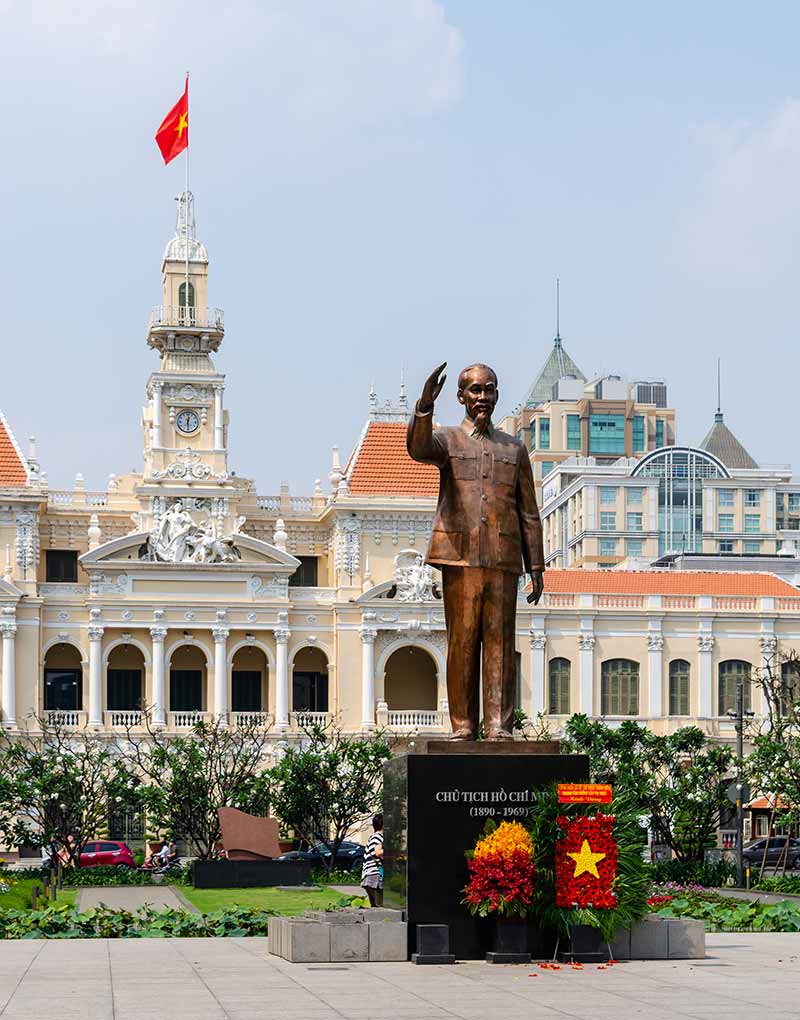
Ho Chi Minh statue in front of his namesake Ho Chi Minh City Hall (built by the French and in the French style in 1902-1908), in his namesake city of Ho Chi Minh, Vietnam
|
 n 1887 France added Vietnam to its imperial properties and put its own unique stamp on what became known as “French Indo-China.” They transplanted French culture, language, and the Roman Catholic Church, until the Japanese took over in 1941. The Revolutionary heritage of France came home to roost after the Second World War and the expulsion of the Japanese army, when a Moscow-trained Communist revolutionary cadre led by Ho Chi Minh announced the Democratic Republic of Vietnam with the capitol city of Hanoi. When the French returned to rule, the Viet Minh began a systematic conquest of the French imperial forces. In 1954, the Viet Minh, backed by Red China, defeated the last French army at the Battle of Dien Bien Phu. The Hanoi regime was recognized and supported by Russia and China, while the United States and Great Britain declared for the French-supported State of Vietnam with the capitol in Saigon. n 1887 France added Vietnam to its imperial properties and put its own unique stamp on what became known as “French Indo-China.” They transplanted French culture, language, and the Roman Catholic Church, until the Japanese took over in 1941. The Revolutionary heritage of France came home to roost after the Second World War and the expulsion of the Japanese army, when a Moscow-trained Communist revolutionary cadre led by Ho Chi Minh announced the Democratic Republic of Vietnam with the capitol city of Hanoi. When the French returned to rule, the Viet Minh began a systematic conquest of the French imperial forces. In 1954, the Viet Minh, backed by Red China, defeated the last French army at the Battle of Dien Bien Phu. The Hanoi regime was recognized and supported by Russia and China, while the United States and Great Britain declared for the French-supported State of Vietnam with the capitol in Saigon.
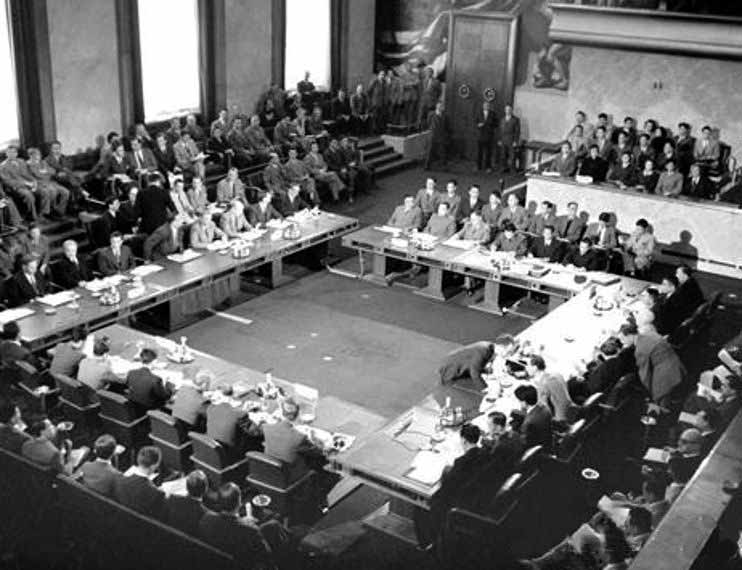
Geneva Conference of July 21, 1954
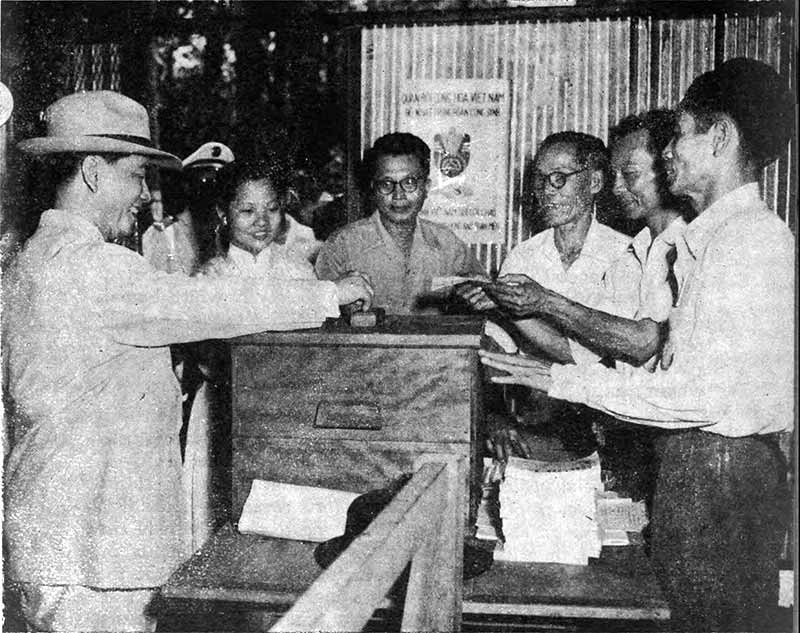
President Ngo Dinh Diem (far left, in hat) casting his vote during the National Assembly elections on March 4, 1956
|
At the 1954 Geneva Conference, Vietnam was temporarily partitioned at the 17th parallel, pending elections to decide if the country would fall into the Communist or the Free World political orbit. The Chinese convinced Ho Chi Minh to stand down his army, arguing that they could win the country at the ballot box. After a CIA psychological warfare campaign, about a million Catholics fled to the south, fearing communist persecution. The refugees, relocated with the aid of the United States, helped vote in Ngo Dinh Diem as President in 1956. With them came 5-10,000 clandestine communist cadres for possible future military action. The communists in the north executed more than 50,000 people during the various “agricultural reforms” instituted prior to the elections. In the North, the communist won “99% of the vote” and in the South, Diem won “133% of the vote.”

The creation of different French colonial entities in Indochina, with dates shown
From 1954-1963 ardent Roman Catholic President Diem ruled South Vietnam, which he dedicated to the Virgin Mary. The majority of the people were Buddhists and many of them resisted, some secretly serving the communist party of the North. The Diem regime arrested multiple thousands of suspected communists, a significant number of whom were executed, as the North created a base to subvert nations on their borders and support an insurgency in the South. The communists in the South announced an assassination campaign in 1957 known as the “extermination of traitors.” During a three-year period, they carried out 2,000 abductions and more than 1,700 assassinations of government officials, village chiefs, hospital workers, and teachers. In 1959 the North Vietnamese Communist Party approved a “Peoples War” against the South.
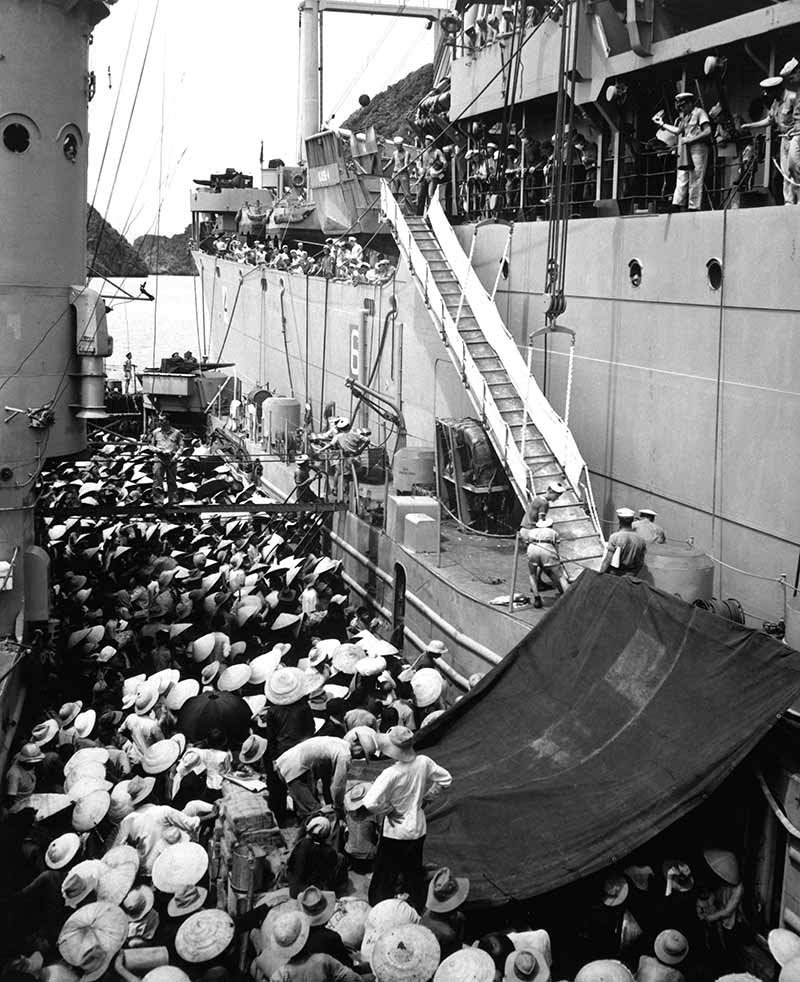
Anti-communist Vietnamese refugees moving from a French LSM landing ship to the
USS Montague during Operation Passage to Freedom in 1954
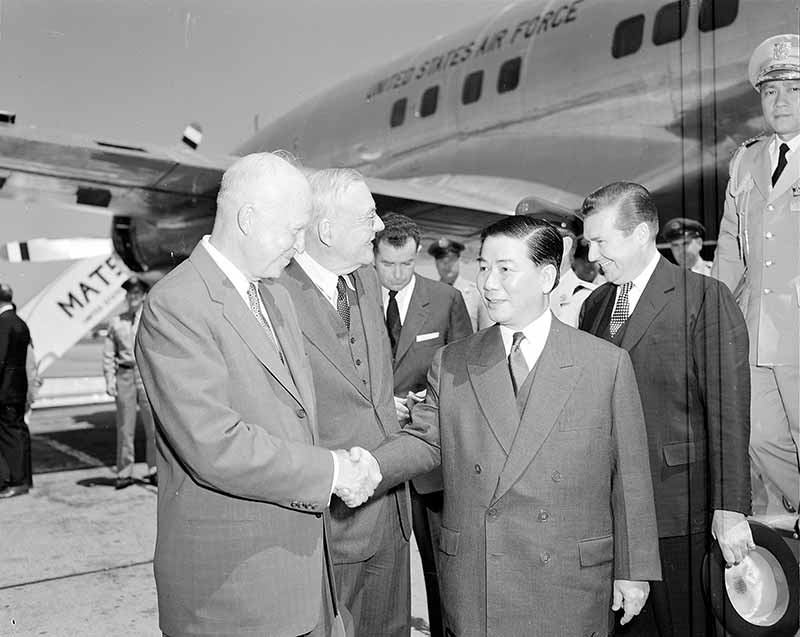
President Diem, accompanied by U.S. Secretary of State John Foster Dulles, arrives at Washington National Airport in 1957 and is shown shaking hands with U.S. President Dwight D. Eisenhower
|
Widespread political corruption, incompetent leadership, and an ineffectual army in South Vietnam spelled doom for the Diem regime. The United States had supplied advisors and logistical support to the South as part of American Cold War policy, but eschewed the commitment of American soldiers. Other foreign policy measures were deemed more vital to U.S. interests in the ongoing Cold War against the Soviet Union, Red China, and Cuba. Eisenhower had put 900 U.S. “advisors” in Vietnam in the 1950s; the new President John Kennedy upped the number to 16,000 by November of 1963. They were supposed to train the ARVN soldiers of South Vietnam, provide counter-insurgency advice and logistical support, and assist in developing better farming techniques and more effective political propaganda for the regime.

A Viet Cong prisoner captured in 1967 by the U.S. Army awaits interrogation
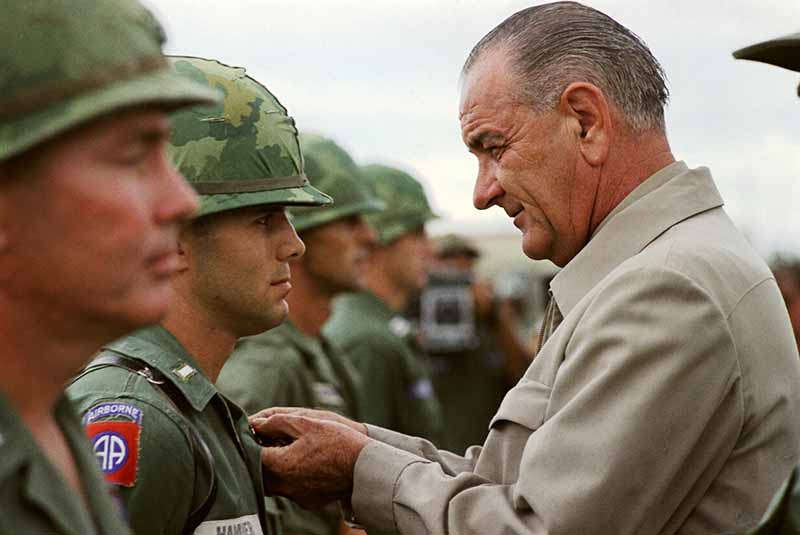
President Johnson awarding a medal to a U.S. soldier during a visit to Vietnam in 1966
|
By 1963, the repression of the Buddhists, military failures to control the communist insurgents (“Viet Cong”), and distrust of Diem and his family resulted in a coup by Vietnamese generals, who killed the Diems, shattering the strong nationalist and Catholic hold on the country. The United States ambassador and the CIA assured the generals beforehand that aid would continue and the U.S. would approve of such action. Success of American attempts to “win the hearts and minds” of the South Vietnamese peasants proved elusive, and the escalation of violence and recurring coups against the generals seemed to presage Northern victory over the South. After the assassination of President Kennedy, Lyndon Johnson—a firm believer in the domino theory that the fall of Vietnam would trigger communist overthrow of governments across Asia—became president of the United States.

Compilation of United States Air Force and United States Naval air operations throughout the Rolling Thunder campaign over North Vietnam, March 2, 1965 – November 2, 1968
Citing an attack by North Vietnamese gunboats on American Naval forces in the Gulf of Tonkin (now known to have never occurred), Congress approved a Resolution to give President Johnson the power to vastly escalate American military commitments to the war in Vietnam, resulting in the unleashing of more than a million tons of bombs, missiles, and artillery strikes on North Vietnam from 1965 to 1968. Congress abdicated its Constitutional responsibility to declare war. Many nations participated in the war with troop commitments. The combat use of American soldiers and marines dramatically increased, eventually reaching about 2.8 million soldiers and sailors fighting in Vietnam. About 58,000 American soldiers were killed and 304,000 wounded. About 250,000 South Vietnamese soldiers died, more than a million from the North. Civilian casualties exceeded two million.
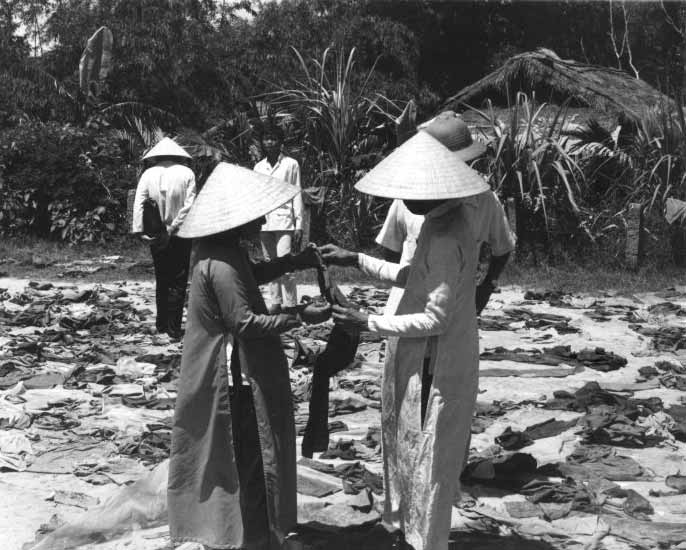
Bits of tattered clothing, sandals and slippers that were found in mass graves are examined by South Vietnamese women who lost relatives in the 1968 Tet massacre
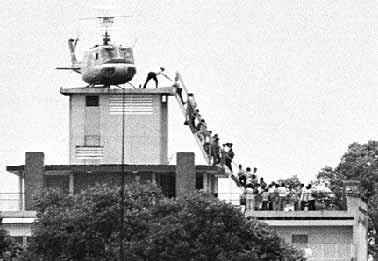
CIA officer helps evacuees up a ladder onto an Air America helicopter at 22 Gia Long Street, Saigon, Vietnam on April 29, 1975
|
The United States and North Vietnam began secret talks in 1973 in Paris to bring the war to an end. A cease-fire went into effect on January 27, 1973, and the last American troops officially left Saigon on March 29. South Vietnam attempted to retain their independence for two more years, but the relentless attacks of the North and the loss of will by the government and the soldiers brought the ultimate downfall of Saigon in April of 1975. U.S. Marines evacuated the United States embassy by helicopter, along with a few Vietnamese, and the country was finally united, with the renaming of Saigon to Ho Chi Minh City.
Historians generally accept the thesis that the United States leaders, both civilian and military, did not fight to win the war and were manipulated by communist diplomacy. The resistance to the war in American popular culture was widespread and influential. American foreign policy once again left a nation in shambles, millions of dead and maimed, and the military forces demoralized and cynical.
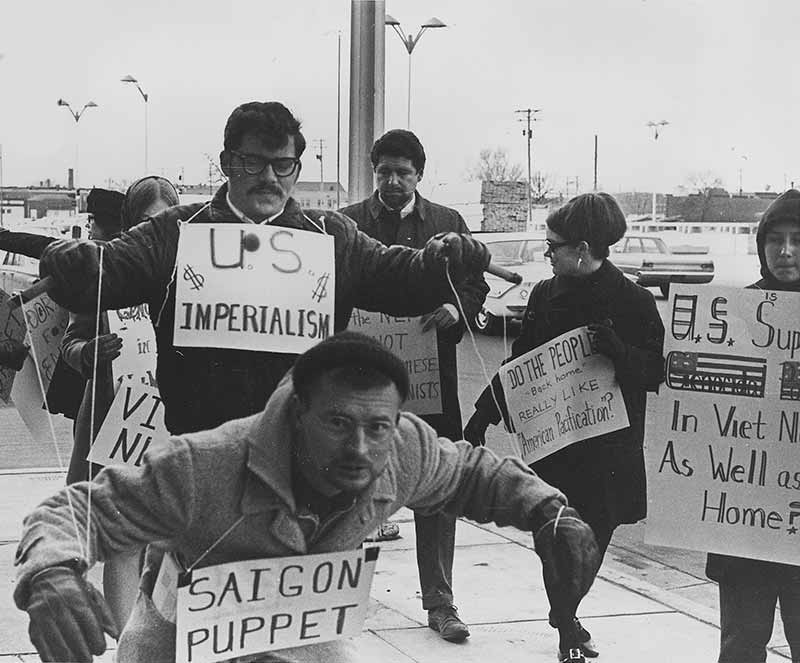
Vietnam War protesters in Wichita, Kansas, 1967

Image Credits:
1 Ho Chi Minh (wikipedia.org)
2 Geneva Conference (wikipedia.org)
3 Diem Voting (wikipedia.org)
4 French Indochina Map (wikipedia.org)
5 Refugees (wikipedia.org)
6 Eisenhower & Diem (wikipedia.org)
7 Viet Cong prisoner (wikipedia.org)
8 Johnson (wikipedia.org)
9 Operation Rolling Thunder footage (wikipedia.org)
10 Searching through debris (wikipedia.org)
11 Helicopter Evacuation (wikipedia.org)
12 Anti-war Protesters (wikipedia.org)
|







